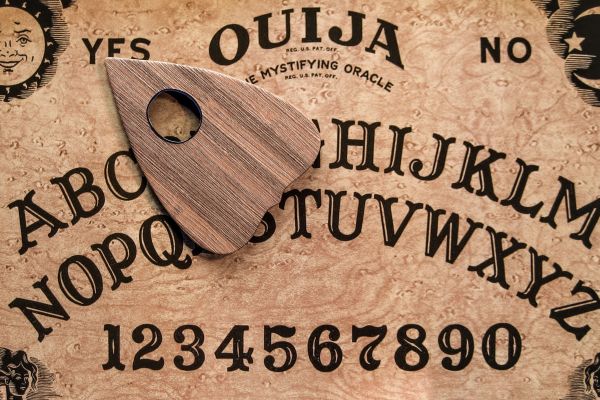
Dr. Ronald Rensink’s Ouija board research featured in Discover Magazine
How fun is that, when you get to use a Ouija board as part of your research?
Dr. Ronald Rensink, Associate Professor Emeritus of Computer Science and Psychology at the University of British Columbia, has used Ouija as a central part of his research, and was recently part of a story published by Discover Magazine about the topic.
If you haven’t heard of Ouija, it’s a game board also known as a ‘spirit board,’ developed commercially around 1900 and is sold by Hasbro. The game uses a pointer to spell out messages on the board seemingly without participants moving the pointer. Long heralded as a direct pipeline to spirits from the world beyond, the game is regarded as spooky entertainment, but is also a fascinating study in human psychology.
Is Ouija all in the mind?
Dr. Rensink and his colleagues Dr. Hélène L. Gauchou from UBC Psychology and Dr. Sid Fels from UBC Electrical and Computer Engineering (ECE) conducted their research and published a paper in 2012. All three of these faculty members were participating in UBC’s Cognitive Systems Program (COGS), a multi-disciplinary undergraduate program involving four departments: Computer Science, Linguistics, Philosophy, and Psychology.
The methodology used in their study provides insight into the unconscious mind, and hypothesizes that at an unconscious level we may know more than we think. In the study, they investigate the question of whether ideomotor actions (unconscious movements) can also express nonconscious knowledge one has. The team did this using a method that drew on the participants’ implicit (or nonconscious) long-term semantic memory, which is not available to conscious recall.
Ronald refers to the system responsible for the behaviour as ‘Zombie mind.’ He started studying this phenomenon when he worked in research for Nissan in relation to humans driving on ‘autopilot.’

“You can be driving along and just kind of zone out because maybe you’ve driven the route a hundred times," said Ronald. You essentially aren’t driving with your conscious mind; you are driving with your nonconscious mind. So we were looking into ways of understanding the driver experience and what we could do to help develop new interfaces in cars.”
Ronald was curious to then learn what’s going on when people are in this zombie state of mind. “Although you are driving nonconsciously, you don’t drive off the road, or into other vehicles,” he said. “So how are you doing this? We began to wonder whether we could test the capabilities of this zombie state using Ouija.”
From CS to psych and beyond
Dr. Rensink studied computer science at UBC and his home lab was the Laboratory for Computational Intelligence. While there, he also got to know the folks in the psychology department, learning much about experimental psychology. After his PhD, he did a postdoc in psychology at Harvard. He eventually ended up at Cambridge Basic Research (CBR), a laboratory and joint effort of Nissan, Harvard, and MIT. He returned to UBC as an assistant professor in the fall of 2000. “I was interested in machine vision and I wanted to help design systems that could see better. This led to the question: how do people see, and maybe we can transfer some of that knowledge to help us build better systems.”
He continued, “Machines face the same problems humans do in terms of using light to interpret the world. So there’s a lot of commonality, and that’s how I ended up involved with Nissan designing interfaces that work well with humans. You need both a sense of what humans can do and what can be done technically, so you require expertise in both areas.”
It was after his return to UBC that he ended up in a conversation about Ouija boards with Dr. Fels and they began to study what’s really going on for the people playing the game.
Ronald explained that one of the main hurdles in their Ouija research was to figure out how to isolate the effect of the conscious system. “You need to be able to park your conscious system and allow yourself to act through your zombie system.” The net effect is that the brain recognizes it doesn't have complete control anymore. He went on to say that when the conscious mind gives up control while playing Ouija (which is easy because multiple people are playing), it lets the zombie system operate. Because it’s not the one in control, it thinks that someone else, or some other intelligence, must be moving the pointer.
“Ouija behavior seems to be controlled by the nonconscious mind. Your mind is saying I no longer have complete control, so I may as well check out,” Ronald said. “That’s when your autopilot system, or Zombie mind, can kick in. If you try to play Ouija alone your mind knows that it has complete control, and so won’t let the zombie mind act. Ouija then doesn’t work."
But I want to believe
The excitement of the unknown and the captivating thought of spirits channeling through Ouija make it a very appealing, magical and mysterious game.
Yet, the results of the 2012 study showed that implicit semantic memory can be expressed through ideomotor actions. That is, the movements of the pointer can more often come from information stored at a nonconscious level, a level not always accessible to the conscious mind. This could be very important for other applications, according to Ronald. “I think one of the many potential opportunities is to use this zombie mind for therapy. It might be along the same vein as hypnosis.”
But that doesn’t mean we all have to stop believing in the power and mystery of Ouija. Because there may be something equally as mysterious and captivating at play here: our own minds.